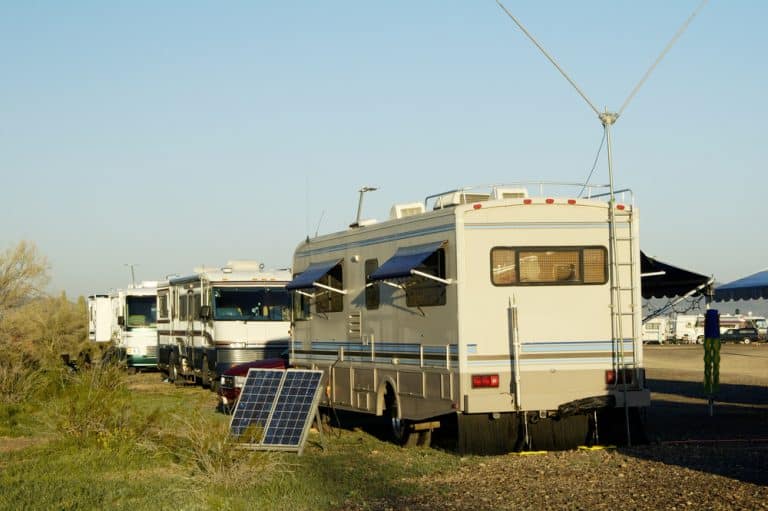Travel Trailers and Solar on the Side

For many adventurers using a camper means more than the occasional glamping trip. It’s a lifestyle. They travel from one place to the next instead of staying in a stationary home. Many of these nomads boondock somewhere. When an RV parks off-grid for extended periods, it’s called boondocking. Since these campsites don’t have water, sewer, or electric hookups, providing these resources requires some ingenuity. To prolong the use of electricity, some have installed solar on their recreational vehicle, so they can have solar on the go. Others purchase solar-ready campers.
Solar on The Go: RVs & Campers Wired for Solar
Some RVs and campers come prewired for solar. Individuals who have this feature in their vehicle can easily add solar. Many solar companies in this niche provide solar panel kits and custom designs for these prewired vehicles. If the travel trailer has this feature, it will have a solar-ready sticker. Some of the brands that carry solar-ready trailers include Jayco, Forest River, and Airstream.
Solar Panel Placement and Solar outlets
The placement of the solar outlet determines which type of solar panel to use. Often solar outlets go either on the roof or side of the vehicle.
Rooftop Entry Plate
Often the roof of the trailer will have the entry plate. The entry plate allows individuals to install solar permanently. If the trailer has a rooftop entry plate, a variety of solar panel options will work. If the RV has round edges, flex solar panels might fit better. However, if it will work, installing solar panels with a stiff frame will last longer.
Solar on the Side Plug
Some RVs and motorhomes come with a solar on the side. Having a plug on the outside wall of the RV means the solar panels can’t go on the roof, making it harder to install a permanent system. Instead, this set up requires portable solar panels. Since these solar panels aren’t on the roof, individuals can set up these solar panels in the sun and park in a shady spot next to the array.
Necessary Components to Install Solar
Solar ready trailers don’t have everything they need to use solar power. Only the wiring comes with it. These systems still need solar panels, fused wires, and a charge controller at the least. If installing on the roof, you will also need a solar mount of some sort. Either a professional can do this, or with a solar panel kit and some demo videos, it can become an at-home DIY solar project.
Installing Solar Panels for RVs
Although installing a system requires a lot of work, having the system prewired makes a big difference. It means the owner doesn’t have to take the trailer apart to conceal the wiring. However, just because the hard part came pre-done doesn’t mean the rest is a cakewalk. An incorrectly installed solar array could cause an electrical fire. Even if a professional does the installation, it’s good to know the basics.
The Essentials for an RV Solar Array
Some things are necessary to power a solar array. These include solar panels, a battery, a charge controller, and an inverter. Since RVs aren’t connected to the grid, power isn’t always readily available, making batteries an essential part of a solar array. A charge controller makes sure the battery doesn’t overcharge or let out charge when it shouldn’t. An inverter converts the direct current generated by solar panels to alternating current, which is necessary for the modules to work. Most household appliances use alternating current, making an inverter essential.
Using Different Solar Panels Than Suggested
Because most solar-ready trailers wire specifically for Zamp, it’s easy to use their solar equipment. However, it isn’t necessarily the cheapest route. Many individuals have found ways to use different solar equipment. Installing other solar equipment takes a little more work and time, but it can also save money.
If installing solar isn’t in the stars, using a solar-powered generator also works. Goal Zero sells solar-powered generators as battery backup. Since a charge controller and inverter come included, electronics can plug into it; nothing extra required.
Difference Between RV and Residential Solar
Installing solar for a home isn’t the same as an RV. Although the basic idea is similar, it’s more complicated to implement. Firstly, homes have different energy needs. Secondly, solar policy for residential installations has more complications. These two factors, among other things, make installing a residential solar array more complex.
How Much Energy Needed for a Home
Homes use more energy than an RV, therefore needing more solar power. However, these solar needs depend on a couple of things. Electric usage of the home over a year shows how much power the homeowner will need. Once the homeowner has determined their energy usage, the hard work begins. The angle of the roof and the amount of unshaded space determines the solar viability of the home, while the type of solar panels determines how many the system will need.
Solar Policy for Residential Installations
Some of the other hurdles for residential installations include interconnection and permits. These two things make solar complicated to complete. Most homes with solar stay connected to the power grid because it’s cheaper than adding enough home battery backup to power the home year-round. However, it also means the homeowner needs approval from their electric utility to install. Permitting provides another hurdle for residential solar. A residential project can’t start until the installation company has a permit for it. Although a challenging process, the ROI of residential solar makes it worthwhile. Homeowners with solar save thousands over the lifetime of the solar array, making residential solar a secure investment.



Send a Message
Oops! We could not locate your form.